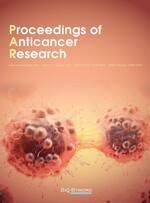Abstract
Objective: To analyze the diagnostic value of fecal Fusobacterium nucleatum detection, fecal immunochemical test (FIT), and carbohydrate antigen 19-9 (CA19-9) detection for colorectal cancer (CRC). Method: A total of 78 CRC patients and 60 healthy individuals were enrolled in this study. Stool and blood samples were collected for the 3 diagnoses, and ROC curves were analyzed for diagnostic value. Result: The 3 diagnoses’ positive detection rates in CRC samples were significantly higher than those of healthy samples (P < 0.05). The combined CRC diagnoses showed significantly higher sensitivity as compared to individual fecal F. nucleatum detection (χ2 = 6.495, P = 0.011), FIT (χ2 = 4.871, P = 0.027), and serum CA19-9 detection (χ2 = 7.371, P = 0.007). The area under the ROC curve for fecal F. nucleatum detection was 0.63 [95% confidence interval (CI) = 1.124–6.238], with a sensitivity of 73.08% and specificity of 85.00%, whereas FIT was 0.65 (95% CI = 1.365–9.241), with a sensitivity of 51.28% and specificity of 96.67%, meanwhile, serum CA19-9 detection was 0.62 (95% CI = 1.517–12.342), with a sensitivity of 69.23% and specificity of 98.33%. The combined CRC diagnoses showed an area under the ROC curve of 0.76 (95% CI = 1.213–6.254), with a sensitivity of 87.18% and specificity of 70.00%. Conclusion: The combined diagnoses of fecal F. nucleatum detection, FIT, and serum CA19-9 detection can significantly improve the sensitivity and accuracy of CRC diagnosis, which has high clinical application value to provide guidance for clinical CRC screening and early intervention treatment.
References
González-González M, Garcia JG, Monstero JAA, et al, 2013, Genomics and Proteomics Approaches for Biomarker Discovery in Sporadic CRC with Metastasis. Cancer Genomics Proteomics, 10(1): 19–25.
Kumar M, Cash BD, 2017, Screening and Surveillance of CRC Using CT Colonography. Curr Treat Options Gastroenterol, 15(1): 168–183. http://doi.org/10.1007/s11938-017-0121-7
Lee JK, Liles EG, Bent S, et al, 2014, Accuracy of Fecal Immunochemical Tests for CRC: Systematic Review and Meta-Analysis. Ann Intern Med, 160(3): 171. http://doi.org/10.7326/M13-1484
Zhu Y, Zhao W, Mao G, 2022, Perioperative Lymphocyte-to-Monocyte Ratio Changes Plus CA199 in Predicting the Prognosis of Patients with Gastric Cancer. J Gastrointest Oncol, 13(3):1007–1021. http://doi.org/10.21037/jgo-22-411
Castellarin M, Warren RL, Freeman JD, et al, 2012, Fusobacterium nucleatum Infection is Prevalent in Human Colorectal Carcinoma. Genome Res, 22(2): 299–306. http://doi.org/10.1101/gr.126516.111
Sung JJY, Lau JYW, Goh KL, et al, 2005, Increasing Incidence of CRC in Asia: Implications for Screening. Lancet Oncol, 6(11): 871–876. http://doi.org/10.1016/S1470-2045(05)70422-8
Aghagolzadeh P, Radpour R. 2016, New Trends in Molecular and Cellular Biomarker Discovery for CRC. World J Gastroenterol, 22(25): 5678–5693. http://doi.org/10.3748/wjg.v22.i25.5678
Sung JJY, Ng SC, Chan FKL, et al, 2015, an Updated Asia Pacific Consensus Recommendations on CRC Screening. Gut, 64(1): 121–132. http://doi.org/10.1136/gutjnl-2013-306503
Yu J, Feng Q, Wong SH, et al, 2017, Metagenomic Analysis of Faecal Microbiome as a Tool Towards Targeted Non-Invasive Biomarkers for CRC. Gut, 66(1): 70–78. http://doi.org/10.1136/gutjnl-2015-309800
Liang Q, Chiu J, Chen Y, et al, 2017, Fecal Bacteria Act as Novel Biomarkers for Noninvasive Diagnosis of CRC. Clin Cancer Res, 23(8): 2061–2070. http://doi.org/10.1158/1078-0432.CCR-16-1599
Ahn J, Sinha R, Pei Z, et al, 2013, Human Gut Microbiome and Risk for CRC. J Natl Cancer Inst, 105(24): 1907–1911. http://doi.org/10.1093/jnci/djt300
McCoy AN, Araújo-Pérez F, Azcárate-Peril A, et al, 2013, Fusobacterium is Associated with Colorectal Adenomas. PLoS One, 8(1): e53653. http://doi.org/10.1371/journal.pone.0053653
Lopez-Siles M, Martinez-Medina M, Surís-Valls R, et al, 2016, Changes in the Abundance of Faecalibacterium prausnitzii Phylogroups I and II in the Intestinal Mucosa of Inflammatory Bowel Disease and Patients with CRC. Inflamm Bowel Dis, 22(1): 28–41. http://doi.org/10.1097/MIB.0000000000000590
Haug U, Hundt S, Brenner H, 2010, Quantitative Immunochemical Fecal Occult Blood Testing for Colorectal Adenoma Detection: Evaluation in the Target Population of Screening and Comparison with Qualitative Tests. Am J Gastroenterol, 105(3): 682–690. http://doi.org/10.1038/ajg.2009.668
Gao Y, Wang J, Zhou Y, et al, 2018, Evaluation of Serum CEA, CA19-9, CA72-4, CA125 and Ferritin as Diagnostic Markers and Factors of Clinical Parameters for CRC. Sci Rep, 8(1): 2732. http://doi.org/10.1038/s41598-018-21048-y
Rao H, Wu H, Huang Q, et al, 2021, Clinical Value of Serum CEA, CA24-2 and CA19-9 in Patients with CRC. Clin Lab, 67(4). http://doi.org/10.7754/Clin.Lab.2020.200828
Wong SH, Kwong TNY, Chow T-C, et al, 2017, Quantitation of Faecal Fusobacterium Improves Faecal Immunochemical Test in Detecting Advanced Colorectal Neoplasia. Gut, 66(8): 1441–1448. http://doi.org/10.1136/gutjnl-2016-312766
Steer T, Collins MD, Gibson GR, et al, 2001, Clostridium hathewayi sp. nov., from Human Faeces. Syst Appl Microbiol, 24(3): 353–357. http://doi.org/10.1078/0723-2020-00044
